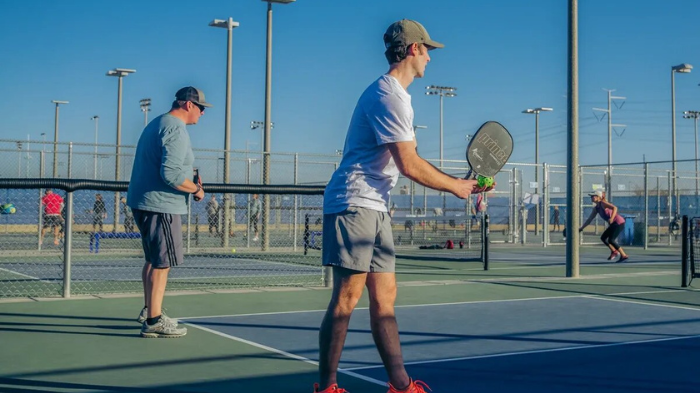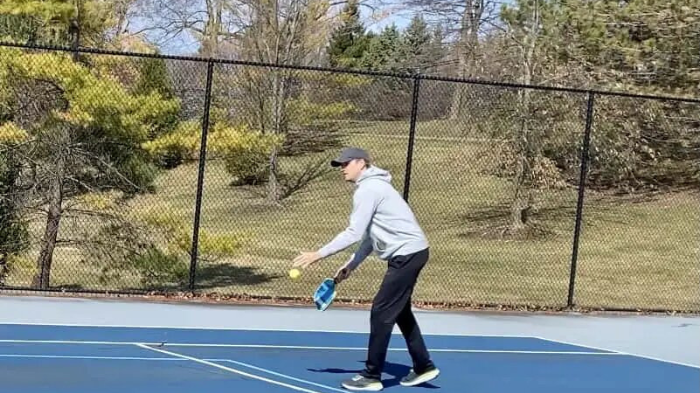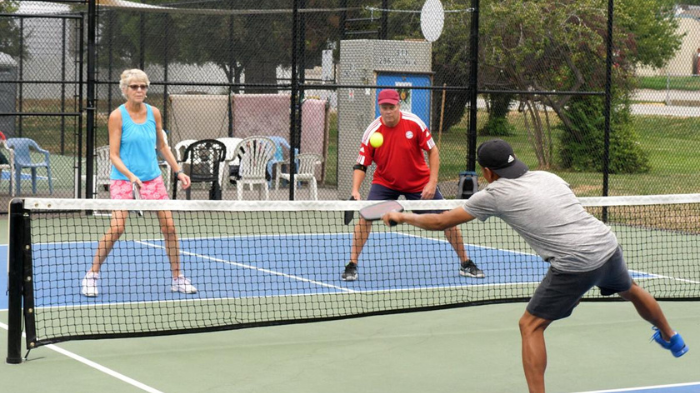Pickleball has gained immense popularity as a fun and competitive sport. However, recent changes in the rules have caused some confusion among players and enthusiasts. One such rule that has undergone significant modification is the let rule in pickleball.
In this blog, we are going to discuss the meaning of a let in pickleball, how it is played, and how many pickleball let serves are allowed. We are also going to discuss the recent changes done in the pickleball let rule, why the let rule in pickleball was removed by the USA Rules Committee, and the benefits of removing that rule in pickleball.
Meaning of Let in Pickleball
In pickleball, a “let” refers to a situation where a served ball touches the net and lands in the proper service court, resulting in a replay of the serve. When a let occurs, the server gets another opportunity to serve without any penalties.

The term “let” in pickleball originates from tennis. In tennis, a let is also called when the ball hits the net but lands in the proper service court, resulting in a replay of the serve. Pickleball, being a racquet sport with similarities to tennis, adopted the term “let” for the same situation.
The term “let” in tennis has a historical origin rooted in the concept of granting the server another attempt without imposing any penalties or consequences. The exact origin of the term “let” in tennis is not definitively known, but it has been used for many years in the sport.
How Many Pickleball Let Serves Are Allowed?
In pickleball, there is no specific limit to the number of let serves allowed. When a pickleball let occurs, it means that the served ball touches the net but still lands in the proper service court. In such cases, the server is granted another opportunity to serve without any penalties or consequences.
Let serves are considered neutral occurrences in pickleball. They are typically replayed to ensure fairness and to give the server a fair chance to deliver a valid serve. This rule recognizes that hitting the net can happen by accident or be influenced by factors like wind or imperfect technique.
So, if a let serve happens in pickleball, the server simply gets another chance to serve. If the subsequent serve also results in a let, the process is repeated until a valid serve is achieved. As long as the served ball touches the net and lands in the proper service court, it will be considered a let, and the server will continue to serve until a valid serve is made.
It is important to note that the rules and interpretations of pickleball let serves may vary slightly in different pickleball organizations or tournaments. However, the general principle remains the same – let serves allow the server to replay the serve without any consequences until a valid serve is achieved.
How Do You Play a Let in Pickleball?
When a let occurs in pickleball, it means that the served ball touches the net but still lands in the proper service court. Here’s how a let is played in pickleball:
- The server gets ready to serve the ball from the back boundary line, following the usual serving rules.
- The server hits the ball, trying to send it over the net and into the opposite diagonal court where the receiving team is positioned.
- If the ball that the server hits touches the net during the serve but still lands within the appropriate service area of the opposing team’s court, it is considered a let, and the serve is replayed.

- When a let is called, the rally is considered nullified, and the server gets another chance to serve without any penalties or consequences.
- The server can serve again as many times as necessary until they successfully execute a valid serve. To have a valid serve, the server must strike the ball in a way that enables it to clear the net without making contact. In addition, the ball must land inside the proper service court without being obstructed or affected by the net or any other obstacles.
- After a valid serve is successfully made, the rally continues, and both teams engage in regular gameplay, aiming to return the ball and score points.
It is important to note that a let in pickleball only applies to the serve. If a let occurs during a subsequent shot or rally after the serve, the point continues, and there are no replays or interruptions for lets during regular play.
Remember that the specific rules and interpretations of lets in pickleball may vary slightly in different pickleball organizations or tournaments, so it is always better to refer to the official rules of the particular event or governing body you are playing under.
Recent Changes to the Let Rule in Pickleball
Recently, there has been a significant change in the let rule of pickleball. In the past, if a serve in pickleball hit the net but still landed correctly in the designated area beyond the non-volley zone, it was considered a let. In such cases, the server was granted another opportunity to serve.
However, as of 2021, the let rule has been completely abolished to uphold the integrity of the game. Consequently, there is no longer any provision for a let in pickleball. Now, if a serve in pickleball hits the net and lands in the right area of the serving court, it is considered a good serve, and the game continues without any pauses or interruptions.
There were multiple reasons for changing this rule. One of the main goals was to make the game faster by reducing delays and creating a more exciting and active playing atmosphere. Another reason was to prevent arguments and ensure fairness by removing the let rule in pickleball. Some people believed that the pickleball let serve gave servers an unfair advantage, allowing them to make unpredictable shots.
Under the new rule, players must declare their call before the ball bounces twice on their side of the court to keep the rally in play. Failure to do so would result in the point being awarded to the opposing team. Players and referees must adjust to this rule modification and refrain from habitually calling let serves. Any player or team that ceases play in response to a let serve will be considered at fault and will lose a point.
Why the USA Rules Committee Removed the Let Rule in Pickleball?
The USA Rules Committee has recently made the decision to remove the let rule in pickleball, underscoring a multitude of reasons that substantiate their choice. Their official statement highlighted their dedication to upholding the integrity of pickleball, prioritizing the well-being of players and officials, and eradicating confusion and inconsistency. The committee provided several specific justifications for this change:
Complexity: The let rule often proved difficult for new players to understand, resulting in frequent disagreements about when a point should be replayed.
Competitiveness: The let rule, which allowed points to be replayed, took away from the competitive nature of pickleball by giving players the opportunity to try again for points they might have otherwise lost.
Game Pace: The let rule added to the slower pace of the game and made spectators wait longer between points, which could make the overall experience less enjoyable.
Consistency: The let rule resulted in discrepancies among referees when determining whether a let should be called, introducing inconsistencies into the game.
External Factors: The let rule was susceptible to external factors like wind or unpredictable bounces, which could compromise the accuracy of determining when a let should be awarded.
Before making this decision, the committee conducted thorough research and testing, which involved trials with players, officials, and spectators. The feedback received from these trials was positive, indicating that removing the let rule improved the flow, fairness, and enjoyment of pickleball.
Benefits of Removing the Pickleball’s Let Rule
The removal of the let rule in pickleball, as endorsed by the USA Rules Committee and some players, offers several benefits, including:
Integrity: Getting rid of the let rule makes sure that there is no chance for cheating or disagreements that can arise from disputed let calls, thus maintaining the fairness and trustworthiness of pickleball.
Player Experience: By removing the let rule, players experience less frustration and have fewer arguments about service errors, resulting in a fairer, more consistent, and more satisfying game for everyone involved.
Simplifying Officiating: Removing the let rule streamlines the responsibilities of officials, preventing confusion and ensuring consistent let calls. This simplification enhances the overall efficiency and smoothness of the officiating process.
Game Pace: The removal of the let rule accelerates the game, minimizing waiting times between points and providing a more engaging experience for spectators by eliminating interruptions and replays.
Flow And Fun: By removing the let rule, pickleball players can have more extended and exciting rallies as they face the challenge of adjusting to a greater variety of shots. Overall, this enhances the game’s flow and brings more enjoyment to the players.

FAQs
In pickleball, a let refers to a situation where the serve touches the net but still lands in the proper service court, resulting in the serve being replayed.
The let rule was removed in pickleball to address several factors, including complexity, competitiveness, game pace, consistency, and external factors. The removal of the let rule was implemented with the objective of improving the overall integrity, fairness, and enjoyment of the game of pickleball.
Yes, the removal of the let rule simplified the officials’ job by eliminating confusion and ensuring consistent let calls. It streamlined the officiating process, resulting in a smoother and more efficient game.
Yes, external factors such as wind or unpredictable bounces that could affect the accuracy of calling lets in pickleball were taken into account. The removal of the let rule in pickleball aimed to minimize the influence of such external factors on the game.
Conclusion
The USA Rules Committee has removed the rules for the let in pickleball because the let rule in pickleball became very difficult for the beginners to understand, resulted in competitiveness, made the spectators waiting for longer time between points, resulted in discrepancies among pickleball referees, etc. The removal of the let rule in pickleball has multiple positive impacts, including promoting fairness within the game, enhancing the overall experience for pickleball players, simplifying the responsibilities of officials, accelerating the pace of the game, and improving the flow of gameplay.
After writing this blog, we hope you have understood what is a let in pickleball, how many pickleball let serves are allowed, how the let in pickleball is played, recent changes done in the pickleball let rule, why the let rule in pickleball was removed, and benefits from the removal of a let in pickleball.



